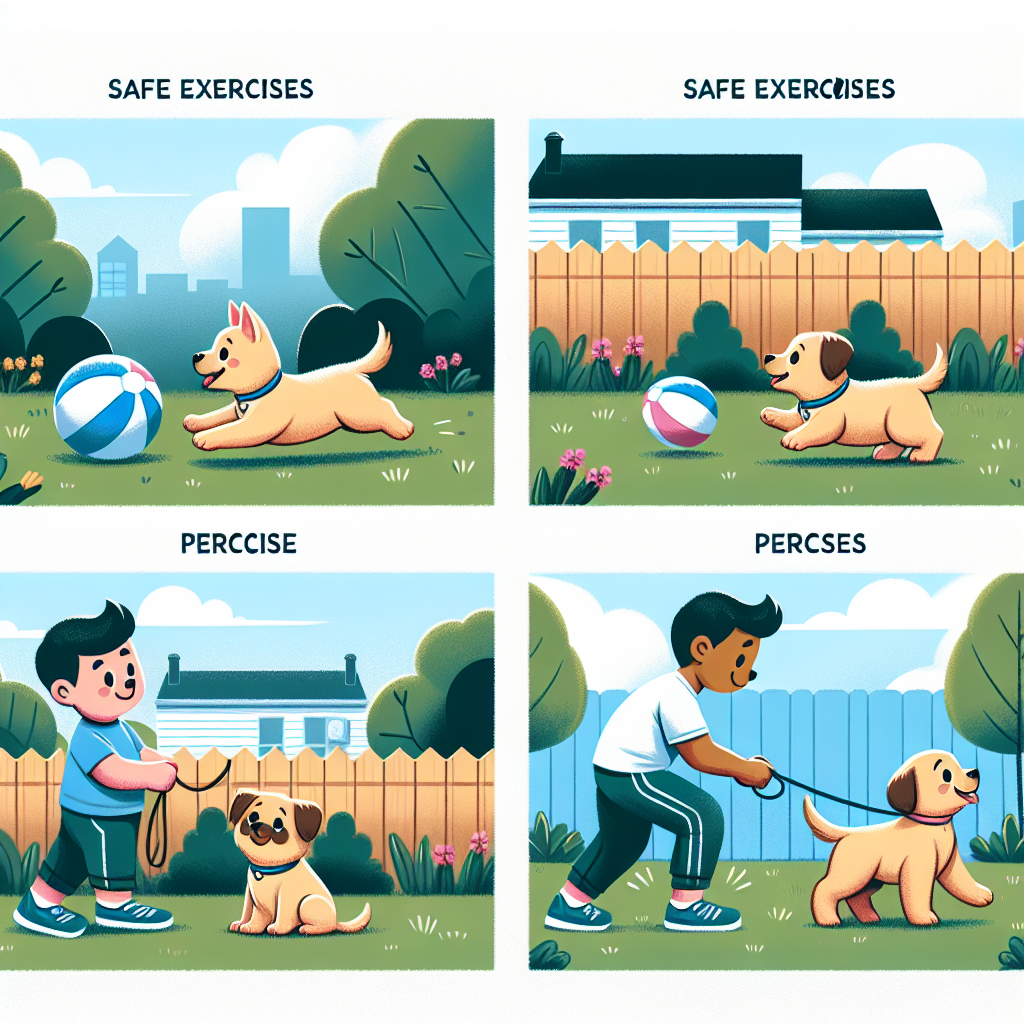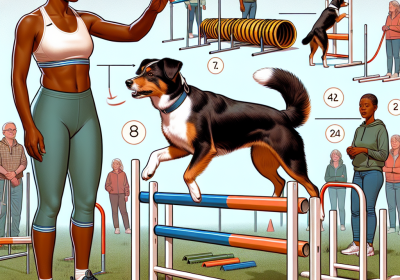Safe exercises for puppies
-
Table of Contents
Introducing safe exercises for puppies is crucial for their physical and mental development. Puppies are full of energy and curiosity, and engaging them in appropriate activities helps build strong muscles, improves coordination, and fosters socialization skills. However, their growing bodies are delicate, and it’s important to choose exercises that are gentle and suitable for their age and breed. Safe exercises include short walks, gentle play sessions, basic obedience training, and interactive toys that stimulate their minds. Always monitor your puppy for signs of fatigue or discomfort, and consult with a veterinarian to tailor an exercise plan that ensures a healthy and happy growth journey.
Gentle Play: Safe Exercise Routines for Young Puppies
When introducing exercise routines to young puppies, it is crucial to prioritize their safety and well-being. Puppies are in a critical stage of development, and their bones, muscles, and joints are still forming. Therefore, engaging them in gentle play and safe exercise routines is essential to ensure they grow up healthy and strong. Understanding the appropriate types of activities and the correct intensity levels can help prevent injuries and promote overall physical and mental health.
To begin with, short and frequent play sessions are more beneficial for puppies than prolonged periods of exercise. Puppies have limited stamina and can tire quickly, so it is important to keep play sessions brief, typically lasting no more than 10 to 15 minutes. This approach not only prevents overexertion but also keeps the puppy engaged and interested in the activities. Additionally, incorporating rest periods between play sessions allows the puppy to recover and reduces the risk of strain or injury.
One of the safest and most effective forms of exercise for puppies is walking. However, it is important to remember that puppies should not be taken on long walks. Instead, short, leisurely strolls around the yard or neighborhood are ideal. These walks provide an opportunity for the puppy to explore their environment, socialize with other dogs and people, and develop good leash manners. It is advisable to avoid walking on hard surfaces such as concrete for extended periods, as this can be harsh on their developing joints. Soft grass or dirt paths are preferable.
In addition to walking, interactive play with toys can be a great way to exercise a puppy. Toys such as soft balls, plush toys, and gentle tug ropes are excellent choices. These toys encourage the puppy to run, chase, and engage in light tugging, which helps build their muscles and coordination. It is important to choose toys that are appropriate for the puppy’s size and strength to prevent choking hazards or injuries. Supervised play is essential to ensure the puppy does not become overly excited or aggressive, which can lead to accidents.
Another beneficial exercise for puppies is swimming. Swimming is a low-impact activity that provides a full-body workout without putting stress on the joints. Many puppies enjoy the water, and it can be a fun and refreshing way for them to burn off energy. However, it is important to introduce swimming gradually and ensure the puppy is comfortable in the water. Using a doggy life jacket can provide additional safety and support, especially for puppies that are new to swimming.
Socialization with other puppies and dogs is also a key component of safe exercise routines. Puppy playdates or attending puppy socialization classes can provide a controlled environment for puppies to interact and play with their peers. These interactions help puppies learn important social skills, such as bite inhibition and appropriate play behavior. It is important to monitor these interactions closely to ensure they remain positive and do not become too rough.
In conclusion, gentle play and safe exercise routines are essential for the healthy development of young puppies. By incorporating short walks, interactive play with appropriate toys, swimming, and socialization, owners can provide their puppies with the physical and mental stimulation they need. Always prioritizing safety and monitoring the puppy’s response to different activities will help ensure they grow into strong, healthy, and well-adjusted adult dogs.
Puppy Yoga: Low-Impact Exercises to Keep Your Pup Healthy

Puppy yoga has emerged as a delightful and beneficial way to engage young dogs in physical activity while fostering a strong bond between pet and owner. This practice, which combines traditional yoga poses with puppy-friendly modifications, offers a low-impact exercise regimen that is particularly suitable for the delicate and developing bodies of puppies. As puppies are still growing, it is crucial to ensure that their physical activities are safe and appropriate for their age and developmental stage. Consequently, puppy yoga provides an excellent solution, promoting both physical health and mental well-being.
One of the primary benefits of puppy yoga is its low-impact nature. Unlike high-intensity exercises that can strain a puppy’s developing joints and muscles, yoga involves gentle movements and stretches that are less likely to cause injury. This is particularly important for breeds that are prone to joint issues, such as large breeds like Labradors and German Shepherds. By engaging in low-impact exercises, puppies can build strength and flexibility without the risk of overexertion or damage to their growing bodies.
Moreover, puppy yoga helps to improve coordination and balance, which are essential skills for young dogs. The various poses and movements involved in yoga require puppies to use different muscle groups and maintain their balance, thereby enhancing their overall physical coordination. This can be particularly beneficial for puppies that are still learning to navigate their environment and develop their motor skills. Additionally, the controlled and deliberate nature of yoga movements can help to prevent accidents and injuries that might occur during more vigorous play.
In addition to the physical benefits, puppy yoga also offers significant mental and emotional advantages. The calming and meditative aspects of yoga can help to reduce stress and anxiety in puppies, promoting a sense of relaxation and well-being. This is especially important for puppies that may be experiencing the stress of adjusting to a new home or environment. The gentle, rhythmic movements of yoga can provide a soothing and comforting experience, helping to alleviate any feelings of nervousness or unease.
Furthermore, puppy yoga provides an excellent opportunity for socialization. Participating in yoga sessions with other puppies and their owners allows young dogs to interact in a controlled and positive environment. This can help to build their confidence and improve their social skills, making them more comfortable and well-adjusted in various social situations. The presence of other puppies and humans can also provide valuable opportunities for learning appropriate behaviors and developing good manners.
Another significant advantage of puppy yoga is the strengthening of the bond between pet and owner. Engaging in a shared activity like yoga fosters a sense of connection and trust, enhancing the overall relationship. The time spent together during yoga sessions allows for positive interactions and reinforces the bond through mutual participation in a calming and enjoyable activity. This can lead to a more harmonious and fulfilling relationship between the puppy and its owner.
In conclusion, puppy yoga offers a multitude of benefits for young dogs, encompassing physical, mental, and emotional well-being. Its low-impact nature makes it a safe and suitable exercise option for developing puppies, while the socialization and bonding opportunities it provides contribute to a well-rounded and happy pet. By incorporating puppy yoga into their routine, owners can ensure that their puppies grow up healthy, confident, and well-adjusted, laying the foundation for a lifetime of good health and strong relationships.
Exploring the Outdoors: Safe Walking Tips for Puppies
When introducing a puppy to the great outdoors, it is essential to ensure their safety and well-being. Walking is a fundamental exercise that promotes physical health and mental stimulation for young dogs. However, it is crucial to approach this activity with caution, considering the unique needs and vulnerabilities of puppies. By following a few key guidelines, you can create a safe and enjoyable walking experience for your furry companion.
First and foremost, it is important to recognize that puppies have developing bones and joints, which are more susceptible to injury than those of adult dogs. Therefore, it is advisable to start with short walks, gradually increasing the duration as the puppy grows and becomes more accustomed to the activity. Initially, a five to ten-minute walk may suffice, allowing the puppy to explore their surroundings without overexertion. As the puppy matures, you can extend the walking time, always monitoring for signs of fatigue or discomfort.
In addition to the duration of the walk, the choice of terrain plays a significant role in ensuring the puppy’s safety. Soft surfaces such as grass or dirt are preferable to hard pavements, as they provide a gentler impact on the puppy’s developing joints. Moreover, these surfaces are less likely to cause abrasions or injuries to the puppy’s delicate paw pads. When walking on unfamiliar terrain, it is prudent to inspect the area for potential hazards such as sharp objects, toxic plants, or uneven ground that could pose a risk to the puppy.
Another critical aspect of safe walking for puppies is the use of appropriate equipment. A well-fitted harness is recommended over a collar, as it distributes pressure more evenly across the puppy’s body and reduces the risk of neck injuries. Additionally, a lightweight leash that allows for some freedom of movement while maintaining control is ideal. It is essential to ensure that the harness and leash are comfortable and secure, preventing any accidental escapes or discomfort during the walk.
Socialization is a vital component of a puppy’s development, and walks provide an excellent opportunity for this. However, it is important to introduce the puppy to new experiences gradually and in a controlled manner. Encountering other dogs, people, and various stimuli can be overwhelming for a young puppy. Therefore, it is advisable to start with quieter, less crowded areas before gradually progressing to busier environments. Positive reinforcement, such as treats and praise, can help the puppy associate these new experiences with positive outcomes, fostering confidence and reducing anxiety.
Furthermore, it is essential to be mindful of the weather conditions when walking a puppy. Extreme temperatures, whether hot or cold, can be detrimental to a puppy’s health. During hot weather, it is advisable to walk during cooler parts of the day, such as early morning or late evening, to prevent overheating. Similarly, in cold weather, it is important to ensure that the puppy is adequately protected from the elements, possibly with a doggy sweater or coat. Always carry water to keep the puppy hydrated, regardless of the weather.
Lastly, observing the puppy’s behavior and physical condition during and after the walk is crucial. Signs of fatigue, limping, or excessive panting may indicate that the puppy needs a break or that the walk was too strenuous. By paying close attention to these signals, you can adjust the walking routine to better suit the puppy’s needs, ensuring a positive and safe experience.
In conclusion, walking is an excellent exercise for puppies, promoting their physical and mental well-being. By starting with short walks, choosing appropriate terrain, using suitable equipment, gradually introducing socialization, being mindful of weather conditions, and closely monitoring the puppy’s behavior, you can create a safe and enjoyable outdoor experience for your young companion.





![The Dog Podcast Uncovers Startling Truths About What We Feed Our Dogs [Press Release]](https://contentsphere.com.au/wp-content/uploads/2024/08/canine-nutrition-ai-400x280.jpg)



